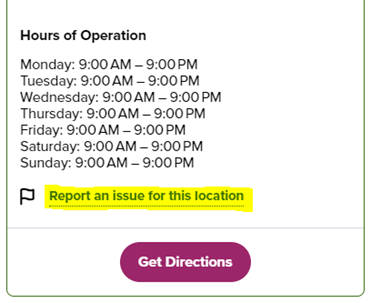
Frequently Asked Questions
FAQ filtered results:
-
Program: Batteries , Hazardous and Special Products , ITT/AV , Lighting , TiresTopic: Collection systems , Municipalities , PRO , Where to Recycle map
Business hours are taken from Google Maps. If the information on Google Maps is incorrect, update your Google account information by following these steps. Note: there may be a delay between the time you update your information in Google and it showing on RPRA’s map.
If the information on Google Maps is correct and not showing on the Where to Recycle map, request to change it through the map directly by:
- looking up the location,
- clicking the location,
- clicking the ‘Report an issue for this location’ link, and
- filling out the form by providing the correct business hours.

-
Program: Batteries , Hazardous and Special Products , ITT/AV , Lighting , TiresTopic: Collection systems , Municipalities , PRO , Where to Recycle map
Only your PRO can update collection site addresses. Ask your PRO to remove the old address from their collection network and add the new address.
The Compliance Team is unable to make changes to the address of a site that has been reported.
-
Program: Batteries , Hazardous and Special Products , ITT/AV , Lighting , TiresTopic: Collection systems , Municipalities , PRO , Where to Recycle map
Collection site names are taken from Google Maps. If the name is wrong, request to change it through the map directly by:
- looking up the location,
- clicking the location,
- clicking the ‘Report an issue for this location’ link, and
- filling out the form by providing the correct name.

-
Program: Batteries , Hazardous and Special Products , ITT/AV , Lighting , TiresTopic: Collection systems , Municipalities , PRO , Where to Recycle map
Collection sites for batteries, electronics, household hazardous waste, lighting, and tires that are reported by producers, or PROs on their behalf, appear on the map.
Collection sites that are considered private (e.g. a recycling bin inside a business that is not accessible to the public) do not appear on the map.
-
Program: Batteries , Hazardous and Special Products , ITT/AV , Lighting , TiresTopic: Collection systems , Municipalities , PRO , Where to Recycle map
A collection site is required to:
- accept all used materials that are designated under the program the collection site operates under*,
- accept materials dropped off free of charge, and
- accept materials dropped off during regular business hours.
The amount and type of materials a collection site must accept varies by which recycling program they operate under.
*More information on what materials must be accepted for each recycling program can be found here.
-
Program: TiresTopic: Collection systems , First Nation communities , Municipalities
Yes. However, if a collection site accepts more than 10 tires from a person on a single day, the operator of the site needs to record the person’s name, contact information and the number of tires accepted at the site from that person.
In their annual performance report, collectors will be asked to report the number of times they accepted more than 10 tires from one person in a single day. The contact information of the person who dropped off the tires must be retained in collectors’ records and produced during any RPRA inspection.
-
Program: Batteries , Blue Box , Hazardous and Special Products , ITT/AV , Lighting , TiresTopic: Collection systems , Collector , First Nation communities , Hauler , Management activities , Municipalities , Processor , Retreader
No. The Authority does not administer contracts or provide incentives. Under the Regulations, producers will either work with a producer responsibility organization (PRO) or work directly with collection sites, haulers, refurbisher’s and/or processors to meet their collection and management requirements. Any reimbursement for services provided towards meeting a producers’ collection and management requirements will be determined through commercial contracts.
To discuss any payment, contact your service provider or a PRO. RPRA does not set the terms of the contractual arrangements between PROs and producers.
-
Program: TiresTopic: Collection systems , First Nation communities , Municipalities
Collection sites are required to accept used tires that are of similar rim size and weight as the new tires (or tires on new vehicles) that they sell. Use the Authority’s Find a Collection Site map to find a drop-off location and call ahead to confirm that the collection site will accept your tires.
-
Program: TiresTopic: Municipalities , Registration
No. Municipalities that collect used tires are exempt from the requirement to register with RPRA as a collector or submit reports. Furthermore, there is no requirement for a municipality to establish a tire collection site. Note that a municipality that arranges for the hauling of tires is required to register as a hauler.
Read the FAQ: ‘How does the Tires Regulation affect municipalities?’ for more information.
-
Program: TiresTopic: Collection systems , First Nation communities , Municipalities , Registration
No. If a municipality has a private company operating a site on their behalf, the company is not required to register the municipally-owned sites as long as the tires are picked up by a registered hauler and delivered to a registered processor or retreader.
If the private company owns or operates collection sites that are not owned by a municipality, it is required to register and report its non-municipally-owned sites.
To ensure tires continue to be picked up from your sites, you will need to make sure those sites are included in the collection systems established by tire producers or producer responsibility organizations (PROs). Since most producers will work with PROs to establish their collection systems, municipalities should contact a registered PRO.
Visit our webpage about PROs for more information.